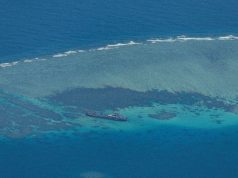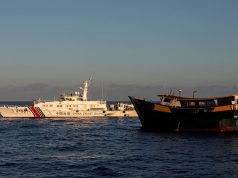Filipinos remembered how former president Benigno “Noynoy” Aquino III asserted the country’s sovereign rights over the West Philippine Sea in commemorating his death anniversary amid current tensions in the area following Chinese encroachment.
Aquino, also colloquially known as “PNoy,” died on June 24, 2021 at 61 years old due to renal disease secondary to diabetes.
READ: Former Philippine President Benigno Aquino dies of renal failure at 61
The late chief executive had suffered from various illnesses before that, or since 2019.
He served as the country’s 15th president from 2010 to 2016.
Aquino was most remembered for bringing China to international court to fight against its sweeping claims in the South China Sea, parts of which include the West Philippine Sea (WPS).
WPS refers to the maritime areas along the western side of the Philippine archipelago within the country’s 200-nautical-mile exclusive economic zone (EEZ).
In 2012, Aquino signed an order renaming parts of the South China Sea within the Philippines’ EEZ as “West Philippine Sea.”
He said these included “the Luzon Sea as well as the waters around, within and adjacent to the Kalayaan Island Group and Bajo de Masinloc, also known as Scarborough Shoal.”
As Filipinos face recent harassment from the Chinese in the Ayungin Shoal or the Second Thomas Shoal, Aquino’s actions against the Asian giant resurface anew.
“Remembering his courage, especially today, in standing up even to the biggest of bullies. May his courage inspire us to always do and fight for what is right,” Celso Santiago Jr., former Presidential Communications Operations Office assistant secretary, said on Monday.
“And may he also remind the most jaded among us that maybe, there is still something in the Filipino worth fighting for,” he added.
Another Filipino also commended Aquino for his actions involving the country’s sovereign rights.
“PNOY — the president who brought China to court and won, who fought for our sovereignty, for what is ours, what is right! Atin ang West Philippine Sea. #WPS,” the online user said.
“He may be gone, but the legacy remains. Ang lakas ng impact ni PNoy sa [kasalukuyang] panahon. Maraming, maraming salamat po sa UNCLOS ruling for the Philippines,” another user wrote.
The official fan account of showbiz personality Kris Aquino, Noynoy’s sister, also posted an old video of the former president.
“When the threat in the West Philippine Sea (WPS) intensified, PNoy’s statement became one: ‘What’s in the Philippines is in the Philippines.’ Year 2011, PNoy and his cabinet studied the filing of the case in the West Philippine Sea in the International Tribunal for the Law of the Sea,” the account said.
“Year 2016, the Philippines won the case filed by PNoy against China. This win is what the Philippines is now using to fight for our territory,” it added.
WATCH: When the threat in the West Philippine Sea (WPS) intensified, PNoy’s statement became one: “What’s in the Philippines is in the Philippines.”
Year 2011, PNoy and his cabinet studied the filing of the case in the West Philippine Sea in the International Tribunal for the… pic.twitter.com/Ymu5xJX4RO
— Kris Aquino (@KrisAquinoWORLD) June 22, 2024
Former senator Bam Aquino, Noynoy’s cousin, also shared a quote from his relative to commemorate the latter’s death anniversary.
“Inaalala namin ang iyong katapangan, katapatan, at kahusayan, PNoy. Maraming salamat sa pagtanggol sa bayan laban sa mga mapang-abuso noon, at sa iyong malalim na pagmamahal sa ating minamahal na Pilipinas,” Bam said.
Inaalala namin ang iyong katapangan, katapatan, at kahusayan, PNoy. Maraming salamat sa pagtanggol sa bayan laban sa mga mapang-abuso noon, at sa iyong malalim na pagmamahal sa ating minamahal na Pilipinas.#RememberingPNoy #SalamatPNoy pic.twitter.com/DzdNHs4xxq
— Bam Aquino (@bamaquino) June 24, 2024
Latest incident
The latest incident in the West Philippine Sea involved the Chinese Coast Guard obstructing the Philippines’ resupply mission at the BRP Sierra Madre in the Ayungin Shoal on June 17.
The Armed Forces of the Philippines said that the Chinese illegally seized at least seven rifles, punctured rigid haul inflatable boats and destroyed various communication equipment and boat engines.
READ: Philippines denounces China’s ‘illegal, aggressive’ actions in South China Sea
The Filipinos were unarmed and fought with their bare hands, while the Chinese had bolos, spears, machetes, and knives, which they used to threaten the former.
A Philippine Navy servicemember also lost his thumb during the confrontation, particularly during the “high-speed ramming incident” between Chinese and Filipino rigid-hull inflatable boats.
READ: Philippines says sailor sustained serious injury in South China Sea collision
The June 17 incident was the latest in a series of escalating confrontations between Chinese and Philippine ships in recent months as China steps up efforts to push its claims to the disputed area.
The historic ruling
In 2013, the Philippines initiated the arbitration under the 1982 United Nations Convention on the Law of the Sea (UNCLOS) dispute settlement procedures, questioning the legality of China’s claims and activities in the South China Sea.
By July 2016, the Permanent Court of Arbitration (PCA) under the United Nations ruled in favor of the Philippines, stating that China’s nine-dash line claim over the disputed waters was invalid.
The international tribunal pointed out that there was no evidence Beijing had exercised exclusive control over the disputed waters or its resources.
The PCA also found that China violated the Philippines’s sovereign rights in its EEZ by interfering with Philippine fishing and petroleum exploration, constructing artificial islands and failing to prevent Chinese fishermen from fishing in the zone.
The Philippines was the first country to challenge China’s expansive claims over the disputed waters.
Vietnam, Malaysia, Indonesia and Singapore also have overlapping claims in the South China Sea.









